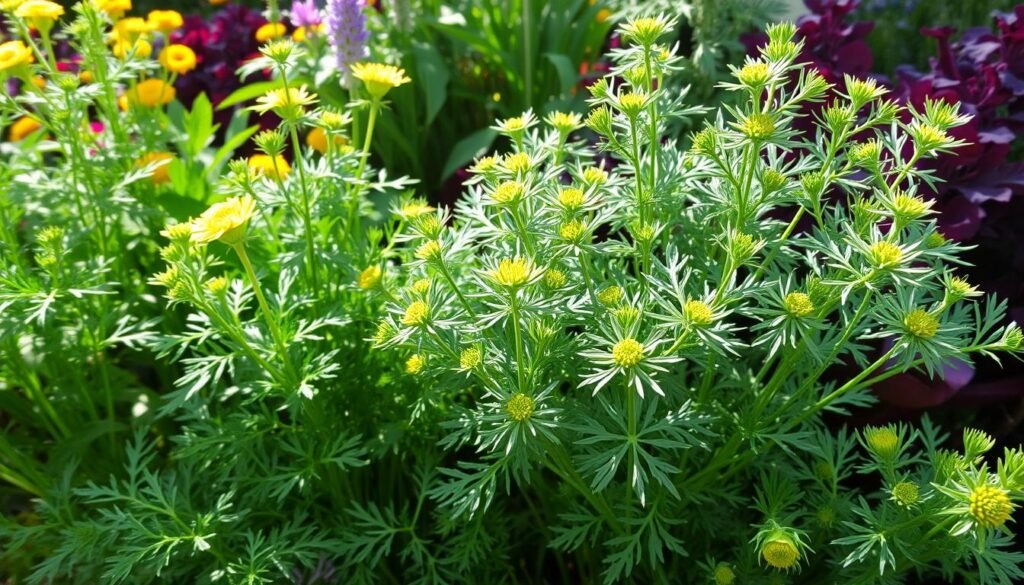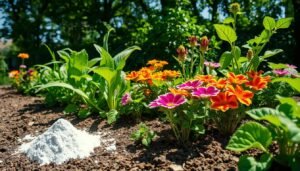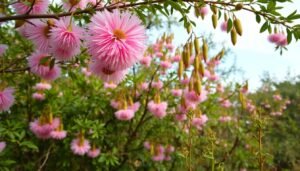Have you ever walked through a grocery store, drawn by the bright greens and smells? You might wonder about dill weed and dill. This happened to me when I tried pickling for the first time. I found a recipe that needed dill weed.
This made me talk to friends and other cooks. We all asked the same thing: is dill weed the same as dill? As I explored the dill plant, I found out they come from the same herb. But they taste and are used differently, like different notes in music.
In this article, I invite you to explore the dill herb with me. We’ll look at its parts and how to use its flavors in cooking.
Key Takeaways
- Dill originated in warm climates and is a resilient herb that thrives even in temperatures as low as 25°F.
- Both dill weed and dill seeds are used widely but possess unique flavors and culinary applications.
- Dill is a staple in various cold-climate countries, including Hungary, Poland, and Ukraine.
- When substituting dill weed, consider using tarragon, parsley, or fresh fennel leaves for an alternative flavor.
- Dill seeds, technically fruit, are commonly used in pickling and in various dishes like bread and frittatas.
- Dill weed pairs well with a range of foods, from fish to potatoes, enhancing the overall dill flavor experience.
What is Dill?
Dill is a plant that adds flavor to many dishes. It comes from the celery family. It has leaves that are used as herbs and seeds that are used as spices.
I love how it tastes. It makes food better and has a long history in cooking.
Origin and Characteristics
Dill grows best in sunny places. It comes from southern Europe and the Balkans, near the Mediterranean Sea. It can handle cold, making it popular in places like Hungary and Poland.
The leaves of the dill plant taste sweet and a bit like grass. They also have a hint of licorice. Fresh dill is strong, while dried dill is milder and minty.
This makes dill great for many dishes. It’s good in pickles, potato salads, and with fish.
Dill in Culinary History
Dill has been used in cooking for centuries. It’s been a key ingredient in pickling for a long time. It’s also great with fish, lighter meats, and veggies.
Dill seeds have a stronger taste. They’re often used in breads, soups, and big meals.
Dill is versatile. It’s good as a garnish in salads and dips. It’s also strong in pickling spices. Its history shows it’s a favorite in many cuisines.
Dill Plant Overview
The dill plant, known as Anethum graveolens, is part of the Apiaceae family. This family also includes parsley and celery. In my gardening, I’ve seen dill grow more than basil.
Dill has unique flowers that start small and grow into big umbels. As it grows, its leaves get longer. The stalks can even reach over four feet tall.
Botanical Classification
Dill’s classification helps us understand how to grow and use it. It likes well-draining soil and lots of sunlight. Even though I mostly grow mint and basil, dill is very hardy.
Dill can spread by self-seeding, thanks to the wind. This makes it grow in different spots in my garden. It can even grow in cooler temperatures, below 25°F.
Growing Conditions for Dill
To grow dill, plant seeds early in spring, a week before the last frost. It takes 10 to 14 days for them to germinate. Once they grow, dill plants can be 18 inches to 4 feet tall.
It’s important to thin seedlings to 3-6 inches apart for them to grow well. If you start with mature stalks, soak them in water until roots grow. Start harvesting when plants are at least three feet tall.
Dill stalks are great for soups or roasts. The leaves are perfect for salads or dips.
Dill Weed Explained
Dill weed is the tender, feathery green parts of the dill plant. I love using fresh dill weed in my cooking. It adds a sweet, grassy taste with a hint of licorice.
This flavor is great with seafood and salads. It makes simple dishes taste amazing.
Defining Dill Weed
Dill weed is a key ingredient in many recipes. It’s used in dips, dressings, and pickling. The fresh leaves add a lively taste to any dish.
For the best flavor, use fresh dill weed. Dried dill has a milder taste with a minty quality. Use one teaspoon of dried dill for every three teaspoons of fresh.
Flavor Profile of Dill Weed
The flavor of dill weed is bright and refreshing. It’s perfect for light dishes. Fresh dill adds bold, grassy notes to potato salads, yogurt dips, and egg dishes.
Dried dill has a strong licorice flavor. It’s different but still enchanting. Dill weed can make any recipe better and adds a vibrant touch.
| Type | Flavor Characteristics | Culinary Applications |
|---|---|---|
| Fresh Dill Weed | Grassy, sweet, hints of licorice | Potato salads, yogurt dips, seafood |
| Dried Dill Weed | Minty, subdued, dominant licorice | Pickling, dressings, dips |
I love dill weed for its unique flavor and versatility. It brightens salads and adds freshness to dips. Knowing the difference between fresh and dried dill helps me cook better.
Dill Seeds Explained
Dill seeds are the mature fruits of the dill plant. They are often overlooked but are very valuable in cooking. Unlike dill weed, dill seeds have a stronger taste. They have an earthy, slightly bitter flavor with hints of anise.
What are Dill Seeds?
Dill seeds are not actual seeds but tiny dry fruits. They are about 1/5 inch long and shaped like a football. Unlike many spices, dill seeds keep their flavor when dried.
They can be harvested from flower stalks and stored for up to six months. This lets me use them in many dishes.
Flavor Profile of Dill Seeds
The flavor of dill seeds is complex. It’s similar to caraway, celery, and anise seeds but has a unique bitter bite. I find that using dill seeds in cooking often leads to great results.
They work well in pickling, soups, and stews. Toasting the seeds before using them can make their flavor even better. They’re great in savory baked goods and fish dishes. For more on dill seed and dill weed, see this article.
| Aspect | Dill Seeds | Dill Weed |
|---|---|---|
| Flavor Intensity | More intense, earthy, slightly bitter | Milder, sweet, grassy |
| Culinary Uses | Pickling, baking, soups, stews | Salads, fish garnishes, dips |
| Storage Life | Up to 6 months when dried | Best used fresh, loses flavor quickly |
| Cooking Method | Must be cooked longer to release flavor | Ideal for cold dishes and fresh use |
Is Dill Weed the Same as Dill?
Learning about dill and dill weed has changed my cooking. They have different tastes, but are used in different ways. Many ask, “Is dill weed the same as dill?” But they come from the same plant and have different uses in cooking.
Understanding the Differences
Dill weed tastes like licorice and is sweet and grassy. It makes dishes bright and refreshing. Dill seed, on the other hand, tastes bittersweet and a bit like anise. It’s crunchy and has a unique flavor.
Culinary Uses of Both Variants
Dill weed is great in dips, salads, and as a fish garnish. It’s mild and pairs well with carrots, peas, and potatoes. Dill seed is perfect for pickling, adding depth to cabbage, lentil, and bread dishes.
Exploring these herbs in cooking can be rewarding. Knowing their flavors and uses is key. For more on culinary herbs, check out bee wings and their role in food systems.
Dill Varieties
Exploring different dill types is rewarding for gardeners and food lovers. Each variety has special traits that can make dishes better or gardening easier. Knowing the main dill varieties helps me grow dill well in many places.
Common Varieties of Dill
Many dill types are known for their unique features and uses in cooking:
- Bouquet Dill: It has a strong flavor and lots of leaves, great for cooking.
- Fernleaf Dill: This variety is small and good for pots, with a mild taste for salads.
- Mammoth Dill: It can grow very tall, perfect for pickling because of its strong taste.
- Dukat Dill: It has a light, sweet flavor and grows lots of leaves, good for many recipes.
- Thai Dill: It’s about 18 inches tall and works well for cooking and pickling.
| Variety | Height | Flavor Profile | Best Use |
|---|---|---|---|
| Bouquet | 2-3 feet | Robust | Culinary |
| Fernleaf | 16-24 inches | Mild | Fresh Cooking |
| Mammoth | Up to 5 feet | Pungent | Pickling |
| Dukat | 2-3 feet | Sweet | Culinary Variety |
| Thai | 18 inches | Versatile | Cooking & Pickling |
Growing Different Dill Varieties
Knowing the right conditions for each dill type is key. Dill likes well-drained soil and lots of sun. I find that changing where I plant dill helps a lot. This is especially true for slow-bolt varieties and those for seeds.
For container gardening, deep pots are best. This lets the dill’s long root grow well. Growing different dills also brings in helpful insects, which fight pests. Growing dill is a fun and varied gardening activity.
Using Dill in Cooking
Dill makes food taste better. It’s a favorite in many kitchens. It’s great in many dishes, from dips to salads.
Popular Dill Recipes
I love making a few dill recipes. They show off dill’s great taste. Here are some favorites:
- Dill-Infused Egg Salad: This dish mixes hard-boiled eggs, mayonnaise, and lots of dill.
- Yogurt-Dill Sauce: It’s perfect for grilled fish or veggies.
- Dill Roasted Vegetables: Season veggies with olive oil, salt, and dill before roasting.
- Dill Pickles: Homemade pickles that show off dill’s tangy side.
Substitutes for Dill Weed and Dill Seeds
When I run out of dill, I use substitutes. Here are my top picks:
- Tarragon: It tastes a bit like anise, similar to dill.
- Fresh Fennel Leaves: They have a mild, sweet taste like dill.
- Parsley: It’s not as distinct as dill but adds freshness.
For dill seeds, I use caraway, anise, or fennel seeds. Caraway seeds work just like dill seeds. Each substitute adds its own flavor, keeping dishes tasty without dill.
Health Benefits of Dill
Dill is more than a tasty herb. It’s packed with health benefits that many don’t know about. This annual herb, known as Anethum graveolens, is full of nutrients. Its health perks make it a great addition to my meals.
Nutritional Profile
Dill is rich in vitamins and minerals. It’s loaded with vitamin A, vitamin C, folate, and riboflavin. It also has calcium, potassium, magnesium, manganese, and phosphorus. One teaspoon of dried dill weed gives you:
| Nutrient | Amount per tsp |
|---|---|
| Calories | 3 |
| Fat | 0 grams |
| Cholesterol | 0 grams |
| Sodium | 2 milligrams |
| Carbohydrates | 1 gram |
| Protein | 0 grams |
Dill’s flavonoids have anti-inflammatory effects. They can lower heart disease risk and blood pressure. Studies show dill helps manage type 2 diabetes by lowering blood sugar. It also aids digestion, reducing bloating and improving bowel movement.
Traditional Uses of Dill for Health
Dill has been used for centuries for its digestive benefits. It’s also a remedy for insomnia and anxiety, thanks to its magnesium and vitamin B. These nutrients help increase melatonin production. Dill’s antioxidants boost immune function by protecting cells and stimulating white blood cells.
Dill is usually safe to eat, but rare allergies can happen. Pregnant or breastfeeding women, and those preparing for surgery, should talk to a doctor before using dill supplements. I love how dill enhances both my food and health.
Dill Seasoning and Flavor in Dishes
Dill’s unique taste and smell are loved in many cuisines. It’s especially popular in Scandinavian and Eastern European cooking. Adding dill to dishes can change flavors and make meals better. Let’s look at how it works as a seasoning and pairs with other foods.
Dill as a Seasoning in Different Cuisines
Dill seasoning is known for its fresh and unique taste. In places like Hungary, Poland, and Ukraine, it’s a key ingredient. It’s great with potatoes, fish, and pickles. Remember, dried dill is stronger than fresh, so use it carefully.
Pairing Dill with Other Ingredients
Pairing dill with the right ingredients makes its flavor even better. It goes well with:
- Lemon
- Garlic
- Yogurt
- Mild cheeses
- Potato salad
- Various vegetables
These pairings create a delicious mix that pleases the taste buds. Dill’s flexibility makes it a great addition to many dishes.
| Ingredient | Complementary Flavor | Cuisine |
|---|---|---|
| Dill Weed | Mild, sweet, with hints of anise | Scandinavian |
| Dill Seed | Intense flavor, hints of lemon | Eastern European |
| Garlic | Rich, savory | Mediterranean |
| Lemon | Zesty, bright | International |
| Yogurt | Creamy, tangy | Middle Eastern |
Conclusion
Learning about dill weed and dill seeds has opened up new possibilities in cooking. I’ve discovered that fresh dill adds a lively taste to dishes. On the other hand, dried dill brings a stronger flavor.
This knowledge has helped me use both forms to their fullest. I’ve come to appreciate their unique qualities. They make my cooking even better.
Dill is not just about taste; it’s also good for you. It’s full of antioxidants and helps with digestion and inflammation. Using fresh or dried dill, it’s a great addition to my meals.
Exploring dill’s uses in cooking and its history has been fascinating. It’s become a key ingredient in my kitchen. This simple herb can truly make my food stand out.






